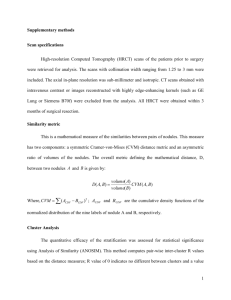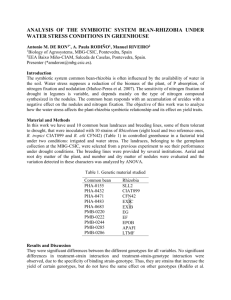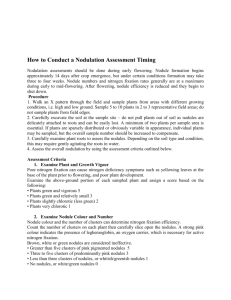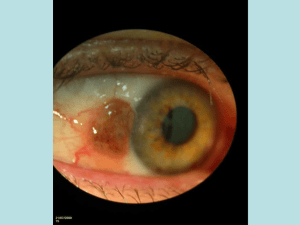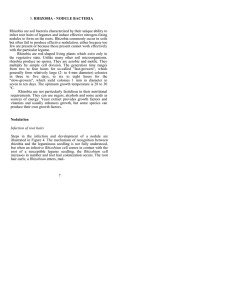Nitrogen Fixation Handout
advertisement
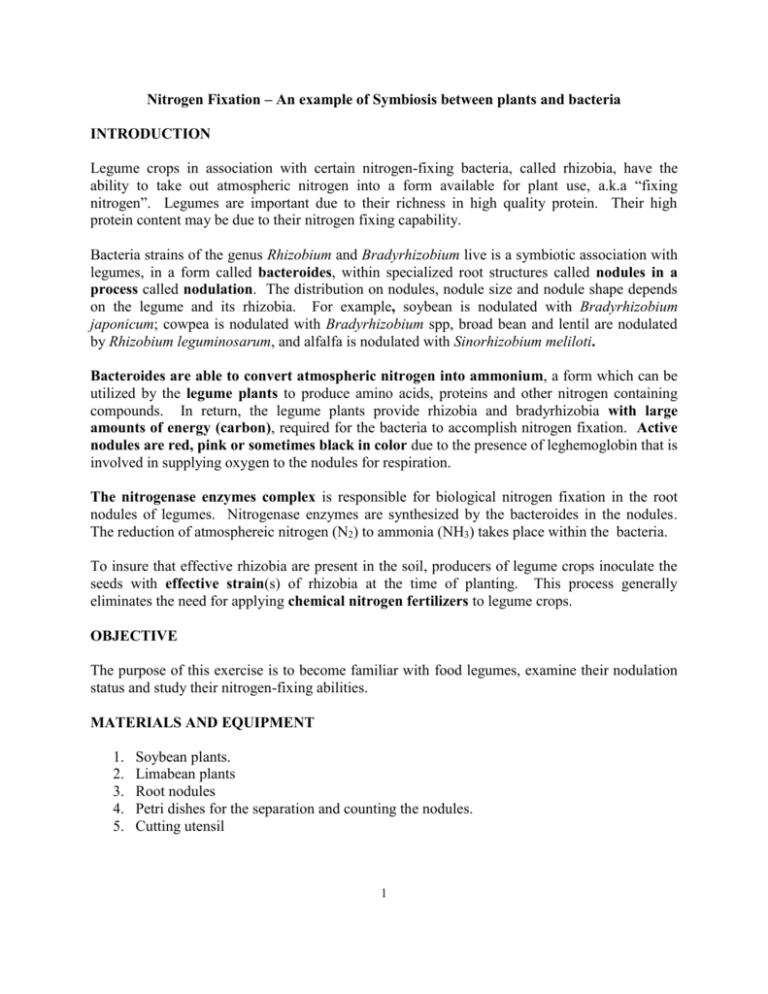
Nitrogen Fixation – An example of Symbiosis between plants and bacteria INTRODUCTION Legume crops in association with certain nitrogen-fixing bacteria, called rhizobia, have the ability to take out atmospheric nitrogen into a form available for plant use, a.k.a “fixing nitrogen”. Legumes are important due to their richness in high quality protein. Their high protein content may be due to their nitrogen fixing capability. Bacteria strains of the genus Rhizobium and Bradyrhizobium live is a symbiotic association with legumes, in a form called bacteroides, within specialized root structures called nodules in a process called nodulation. The distribution on nodules, nodule size and nodule shape depends on the legume and its rhizobia. For example, soybean is nodulated with Bradyrhizobium japonicum; cowpea is nodulated with Bradyrhizobium spp, broad bean and lentil are nodulated by Rhizobium leguminosarum, and alfalfa is nodulated with Sinorhizobium meliloti. Bacteroides are able to convert atmospheric nitrogen into ammonium, a form which can be utilized by the legume plants to produce amino acids, proteins and other nitrogen containing compounds. In return, the legume plants provide rhizobia and bradyrhizobia with large amounts of energy (carbon), required for the bacteria to accomplish nitrogen fixation. Active nodules are red, pink or sometimes black in color due to the presence of leghemoglobin that is involved in supplying oxygen to the nodules for respiration. The nitrogenase enzymes complex is responsible for biological nitrogen fixation in the root nodules of legumes. Nitrogenase enzymes are synthesized by the bacteroides in the nodules. The reduction of atmosphereic nitrogen (N2) to ammonia (NH3) takes place within the bacteria. To insure that effective rhizobia are present in the soil, producers of legume crops inoculate the seeds with effective strain(s) of rhizobia at the time of planting. This process generally eliminates the need for applying chemical nitrogen fertilizers to legume crops. OBJECTIVE The purpose of this exercise is to become familiar with food legumes, examine their nodulation status and study their nitrogen-fixing abilities. MATERIALS AND EQUIPMENT 1. 2. 3. 4. 5. Soybean plants. Limabean plants Root nodules Petri dishes for the separation and counting the nodules. Cutting utensil 1 PROCEDURES PART ONE: Plant morphology and nodulation status 1. Study the plant morphology (shape, structure, etc.) of both soybean and lima bean plants including their stems, roots, leaves, color. 2. Wash the roots thoroughly and carefully. Make sure not to loose any nodules. 3. Examine the distribution of nodules on the roots of soybean and lima bean plants. Record your results. Are the nodules concentrated on the main root or the lateral roots? Use the attached illustration to examine the shape, size and the distribution of nodules on the root system of each plant. 4. Examine the shape and size of the nodules while they are still attached to the roots. 5. Separate the nodules and count them (if possible). PART TWO: Examining the nodule activity in broad bean and lentil 1. Cut TEN nodules from each of the plants with a cutting utensil 2. Record the inside color of each nodule. Is it white, green, brown or black? Please note that the interior color of the nodules usually gives an indication of the nitrogen fixating abilities of these bacteria that live inside the nodules, rhizobia. 3. Determine the percentage of nodule activity. Is the interior color of the nodule red, brown, black, white or green? Nodule activity = (Number of active nodules/total number of nodules) X 100 Active nodules are those nodules that their inside color is pink, red, brown or black. 4. Record the results of your group and those of the other groups in the attached chart. PART THREE: Results and Discussion 1. Record your results and those of other three students in the table provided 2. Answer the question in the “Discussion” section. 2 RESULTS Examination of broad bean and lentil nodulation Name: ----------------------------------------------- Section: ---------------------Crop Nodule # Student’s name Soybean Per plant 1. Your results 2 3 4 Mean Limabean 1. Your results 2 3 4 Mean 2. Nodule size: L, large; M, medium and S, small 3 Nodule Shape Nod. Size* (L, M, S) Active nod, % DISCUSSION I. Define the following terms? (May use dictionary or textbook in the background section isn’t enough) Nodulation: Nodules: Root nodule bacteria: Rhizobia: Legume plants: Biological Nitrogen fixation: II. Answer the following questions? a. Were there any differences observed in the number, shape and distribution of the nodules on the roots of broad bean and lentil? b. Were all nodules active? What is the percentage of nodule activity of each crop? 4 c. What indicates nodule activity? III. Briefly discuss the following: Importance of the biological nitrogen fixation process to: a. The growth of legume plants as well as the follow years’ crops. b. Soil fertility, and c. The environment 5
